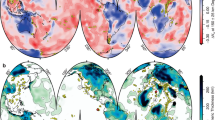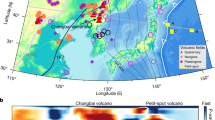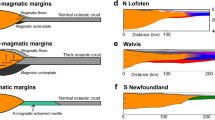Abstract
Most of Earth’s volcanism occurs at plate boundaries, in association with subduction or rifting. A few high-volume volcanic fields are observed both at plate boundaries and within plates, fed by plumes upwelling from the deep mantle1. The remaining volcanism is observed away from plate boundaries. It is typically basaltic, effusive and low volume, occurring within continental interiors2,3,4,5,6,7 or creating seamounts on the ocean floor8,9,10,11. This intraplate volcanism has been attributed to various localized processes12 such as cracking of the lithosphere8,13,14, small-scale convection in the mantle beneath the lithosphere15,16,17 or shear-induced melting of low-viscosity pockets of asthenospheric mantle that have become embedded along the base of the lithosphere18. Here we compare the locations of observed intraplate volcanism with global patterns of mantle flow from a numerical model. We find a correlation between recent continental and oceanic intraplate volcanism and areas of the asthenosphere that are experiencing rapid shear due to mantle convection. We detect particularly high correlations in the interior of the continents of western North America, eastern Australia, southern Europe and Antarctica, as well as west of the East Pacific Rise in the Pacific Ocean. We conclude that intraplate volcanism associated with mantle convection is best explained by melting caused by shear flow within the asthenosphere, whereas other localized processes are less important.
This is a preview of subscription content, access via your institution
Access options
Subscribe to this journal
Receive 12 print issues and online access
$259.00 per year
only $21.58 per issue
Buy this article
- Purchase on Springer Link
- Instant access to full article PDF
Prices may be subject to local taxes which are calculated during checkout



Similar content being viewed by others
References
Courtillot, V., Davaille, A., Besse, J. & Stock, J. Three distinct types of hotspots in the Earth’s mantle. Earth Planet. Sci. Lett. 205, 295–308 (2003).
Valentine, G. A. & Hirano, N. Mechanisms of low-flux intraplate volcanic fields—Basin and Range (North America) and northwest Pacific Ocean. Geology 38, 55–58 (2010).
Demidjuk, Z. et al. U-series isotope and geodynamic constraints on mantle melting processes beneath the Newer Volcanic Province in South Australia. Earth Planet. Sci. Lett. 261, 517–533 (2007).
Johnson, R. W. Intraplate Volcanism in Eastern Australia and New Zealand (Cambridge Univ. Press, 1989).
Gans, P. B. & Bohrson, W. A. Suppression of volcanism during rapid extension in the Basin and Range Province, United States. Science 279, 66–68 (2007).
Faccenna, C. & Becker, T. W. Shaping mobile belts by small-scale convection. Nature 465, 602–605 (2010).
Ebinger, C. J. & Sleep, N. H. Cenozoic magmatism throughout east Africa resulting from impact of a single plume. Nature 395, 788–791 (1998).
Forsyth, D. W., Harmon, N., Scheirer, D. S. & Duncan, R. A. Distribution of recent volcanism and the morphology of seamounts and ridges in the GLIMPSE study area: Implications for the lithospheric cracking hypothesis for the origin of intraplate, non-hot spot volcanic chains. J. Geophys. Res. 111, B11407 (2006).
Scheirer, D. S., Forsyth, D. W., Cormier, H-M. & Macdonald, K. C. Shipboard geophysical indications of asymmetry and melt production beneath the East Pacific Rise near the MELT Experiment. Science 280, 1221–1224 (1998).
Conder, J. A., Forsyth, D. W. & Parmentier, E. M. Asthenospheric flow and asymmetry of the East Pacific Rise, MELT area. J. Geophys. Res. 107, 2344 (2002).
Davis, E. E. & Karsten, J. L. On the cause of the asymmetric distribution of seamounts about the Juan de Fuca ridge: Ridge-crest migration over a heterogeneous asthenosphere. Earth Planet. Sci. Lett. 79, 385–396 (1986).
Raddick, M. J., Parmentier, E. M. & Scheirer, D. S. Buoyant decompression melting: A possible mechanism for intraplate volcanism. J. Geophys. Res. 107, 2228 (2002).
Turcotte, D. L. & Oxburgh, E. R. Intra-plate volcanism. Phil. Trans. R. Soc. Lond. A 288, 561–579 (1978).
McKenzie, D. & Bickle, M. J. The volume and composition of melt generated by extension of the lithosphere. J. Petrol. 29, 625–679 (1988).
King, S. D. & Ritsema, J. African hot spot volcanism: Small-scale convection in the upper mantle beneath cratons. Science 290, 1137–1140 (2000).
Elkins-Tanton, L. T. Continental magmatism, volatile recycling, and a heterogeneous mantle caused by lithospheric gravitational instabilities. J. Geophys. Res. 112, B03405 (2006).
Ballmer, M. D., van Hunen, J., Ito, G., Bianco, T. A. & Tackley, P. J. Intraplate volcanism with complex age–distance patterns: A case for small-scale sublithospheric convection. Geochem. Geophys. Geosyst. 10, Q06015 (2009).
Conrad, C. P., Wu, B., Smith, E. I., Bianco, T. A. & Tibbetts, A. Shear-driven upwelling induced by lateral viscosity variations and asthenospheric shear: A mechanism for intraplate volcanism. Phys. Earth Planet. Int. 178, 162–175 (2010).
Naliboff, J. B., Conrad, C. P. & Lithgow-Bertelloni, C. Modification of the lithospheric stress field by lateral variations in plate-mantle coupling. Geophys. Res. Lett. 36, L22307 (2009).
Molnar, P., Houseman, G. A. & Conrad, C. P. Rayleigh–Taylor instability and convective thinning of mechanically thickened lithosphere: Effects of non-linear viscosity decreasing exponentially with depth and of horizontal shortening of the layer. Geophys. J. Int. 133, 568–584 (1998).
Conrad, C. P. & Behn, M. D. Constraints on lithosphere net rotation and asthenospheric viscosity from global mantle flow models and seismic anisotropy. Geochem. Geophys. Geosyst. 11, Q05W05 (2010).
Debayle, E., Kennett, B. & Priestley, K. Global azimuthal seismic anisotropy and the unique plate-motion deformation of Australia. Nature 433, 509–512 (2005).
Becker, T. W., Schulte-Pelkum, V., Blackman, D. K., Kellogg, J. B. & O’Connell, R. J. Mantle flow under the western United States from shear wave splitting. Earth Planet. Sci. Lett. 247, 235–251 (2006).
Wessel, P. Global distribution of seamounts inferred from gridded Geosat/ERS-1 altimetry. J. Geophys. Res. 106, 19431–19441 (2001).
Hillier, J. K. Pacific seamount volcanism in space and time. Geophys. J. Int. 168, 877–889 (2007).
Ito, G. & Mahoney, J. J. Flow and melting of a heterogeneous mantle: 2. Implications for a chemically non-layered mantle. Earth Planet. Sci. Lett. 230, 47–63 (2005).
Fishwick, S., Heintz, M., Kennett, B. L. N., Reading, A.M. & Yoshizawa, K. Steps in lithospheric thickness within eastern Australia, evidence from surface wave tomography. Tectonics 27, TC4009 (2008).
Dixon, J. E., Dixon, T. H., Bell, D. R. & Malservisi, R. Lateral variation in upper mantle viscosity: Role of water. Earth Planet. Sci. Lett. 222, 451–567 (2004).
Hirth, G. & Kohlstedt, D. L. in Inside the Subduction Factory (ed. Eiler, J.) 83–105 (Geophys. Monogr., Vol. 138, American Geophysical Union, 2003).
Müller, R. D., Sdrolias, M., Gaina, C, Steinberger, B. & Heine, C. Long-term sea-level fluctuations driven by ocean basin dynamics. Science 319, 1357–1362 (2008).
Acknowledgements
We thank S. King and J. Hillier for comments that improved the manuscript. This work was supported by NSF grant OCE-0937319, the Nevada Agency for Nuclear Projects and the Clark County Department of Comprehensive Planning, Nuclear Waste Division. This is SOEST contribution 8081.
Author information
Authors and Affiliations
Contributions
C.P.C., T.A.B. and E.I.S. developed the statistical comparisons between continental volcanism and asthenospheric shear; C.P.C. and P.W. developed the statistical comparisons between seamount databases, asthenospheric shear and seafloor spreading rates; C.P.C. prepared the manuscript with input, comments and review from all authors.
Corresponding authors
Ethics declarations
Competing interests
The authors declare no competing financial interests.
Supplementary information
Supplementary Information
Supplementary Information (PDF 1978 kb)
Rights and permissions
About this article
Cite this article
Conrad, C., Bianco, T., Smith, E. et al. Patterns of intraplate volcanism controlled by asthenospheric shear. Nature Geosci 4, 317–321 (2011). https://doi.org/10.1038/ngeo1111
Received:
Accepted:
Published:
Issue Date:
DOI: https://doi.org/10.1038/ngeo1111
This article is cited by
-
Intraplate volcanism influenced by distal subduction tectonics at Jeju Island, Republic of Korea
Bulletin of Volcanology (2015)
-
Geochronology and geochemistry of the Late Triassic Longtan pluton in South China: termination of the crustal melting and Indosinian orogenesis
International Journal of Earth Sciences (2014)
-
Mantle plumes persevere
Nature Geoscience (2011)
-
Eruptions above mantle shear
Nature Geoscience (2011)



